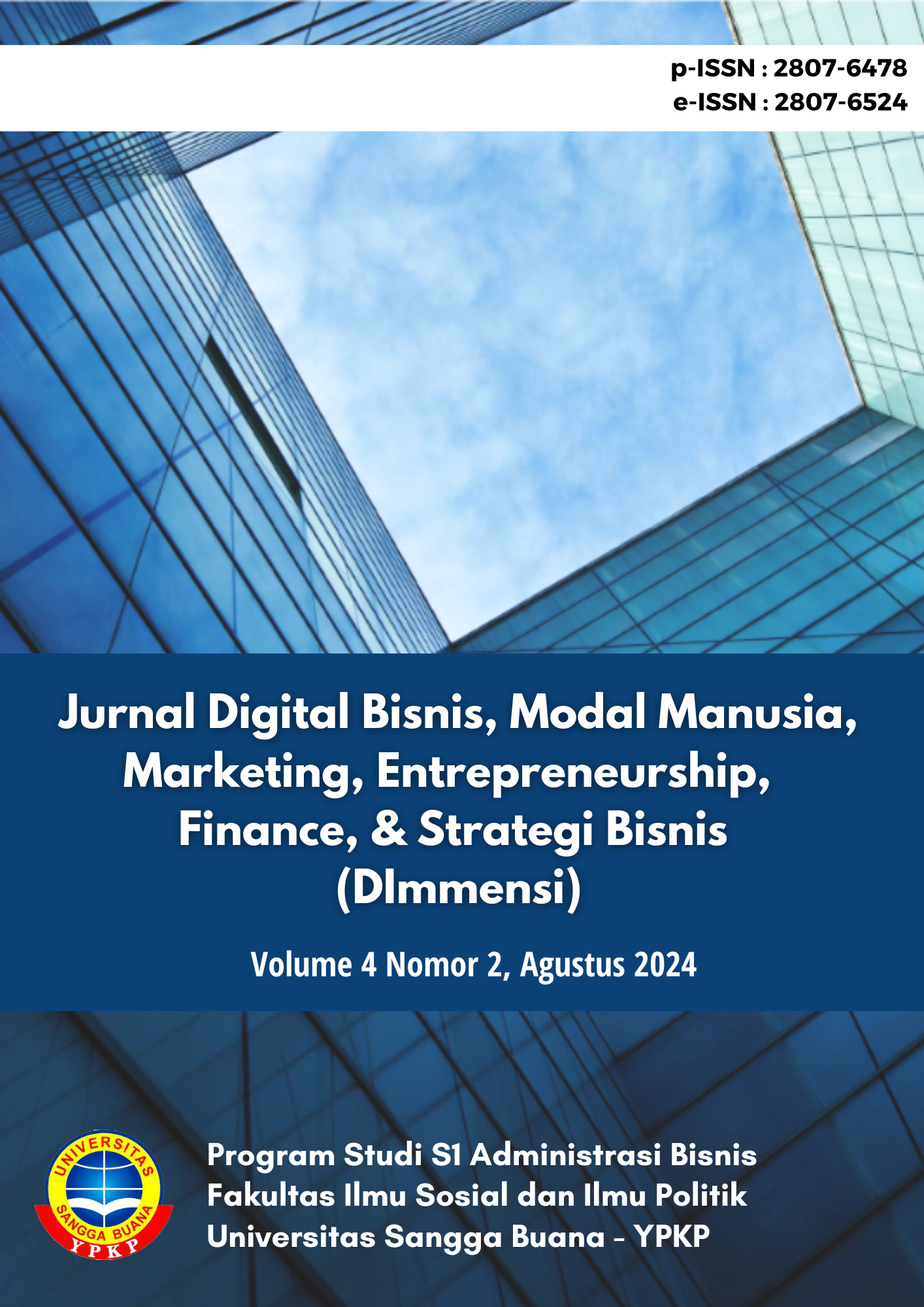Analisis Pengaruh PMW Terhadap Pertumbuhan Kelompok Usaha Mahasiswa Woolivers Domba Berdasarkan Metode Berpikir Desain
Main Article Content
Abstract
Program Pembinaan Mahasiswa Wirausaha (P2MW) dirancang untuk membantu mahasiswa mengembangkan keterampilan kewirausahaan melalui bantuan dana, pendampingan, dan pelatihan usaha. Penelitian ini bertujuan untuk menganalisis pengaruh P2MW terhadap pertumbuhan kelompok usaha Woolivers Domba. Woolivers Domba adalah kelompok usaha yang bergerak di bidang manufaktur dan teknologi, khususnya pada fashion kulit domba. Metode penelitian yang digunakan adalah pendekatan kualitatif deskriptif dengan menggunakan pendekatan berpikir desain. Data dikumpulkan melalui wawancara dengan kelompok usaha terkait, kemudian dianalisis dengan pendekatan berpikir desain. Hasil penelitian menunjukkan bahwa dengan berpartisipasi dalam P2MW membantu menggali potensi dalam mengembangkan bisnis terutama dalam pemahaman terhadap aspek bisnis, mulai dari pencarian ide hingga kepatuhanterhadap regulasi yang berlaku. Meskipun begitu terdapat beberapa hal yang tidak optimal sehingga mempengaruhi Woolivers dalam menghadapi tantangan. Studi ini memberikan wawasan tentang peran P2MW dalam memfasilitasi perkembangan kewirausahaan mahasiswa, dengan implikasi untuk mewujudkan Indonesia Emas pada tahun 2045.
Article Details
Copyright Notice
Authors retain copyright and grant the journal right of first publication with the work simultaneously licensed under a Creative Commons Attribution 4.0 International License that allows others to share the work with an acknowledgement of the work's authorship and initial publication in this journal.
References
Ardian, N. F., & Werdhaningsih, H. (2019). Penggunaan Design Thinking Dalam Pengembangan Produk Kerajinan Ikm (Studi Kasus: Sentra Kerajinan Patung Kayu, Subang). Jurnal Dimensi Seni Rupa Dan Desain, 15(1), 1–16. https://doi.org/10.25105/dim.v15i1.4193
Lailatul Muarofah Hanim, & Sa’adatul Ahlas. (2020). Orientasi Masa Depan dan Kecemasan Menghadapi Dunia Kerja pada Mahasiswa. Jurnal Penelitian Psikologi, 11(1), 41–48. https://doi.org/10.29080/jpp.v11i1.362
Loppies, L. R., Asnawi, A., & Leasiwal, T. C. (2022). Keberhasilan Program Kewirausahaan Mahasiswa ( the Effect of Financial Management Ability and. Jurnal Manajemen Bisnis, 05(02), 101–112.
Nisa, K. (2018). Analisis Kesalahan Berbahasa Pada Berita Dalam Media Surat Kabar Sinar Indonesia Baru. Jurnal Bindo Sastra, 2(2), 218. https://doi.org/10.32502/jbs.v2i2.1261
Sari, I. P., Kartina, A. H., Pratiwi, A. M., Oktariana, F., Nasrulloh, M. F., & Zain, S. A. (2020). Implementasi Metode Pendekatan Design Thinking dalam Pembuatan Aplikasi
HapSari, I. P., Kartina, A. H., Pratiwi, A. M., Oktariana, F., Nasrulloh, M. F., & Zain, S. A. (2020). Implementasi Metode Pendekatan Design Thinking dalam Pembuatan Aplikasi Happy Cl. Edsence: Jurnal Pendidikan Multimedia, 2(1), 45–55.
Sugiyono. (2018). Metode Penelitian Kuantitatif, Kualitatif, dan R&D (Issue January).
Surya, R. Z., & Rosliana, R. (2020). Brainstorming Business Model Canvas Pada Formulasi Strategi “Rabuk Diyang” Sebagai Produk Khas Kabupaten Indragiri Hilir. Selodang Mayang: Jurnal Ilmiah Badan Perencanaan Pembangunan Daerah Kabupaten Indragiri Hilir, 6(1), 8–14. https://doi.org/10.47521/selodangmayang.v6i1.141
Suryati, A., Murwaningsari, E., & Mayangsari, S. (2022). Keunggulan Kompetitif: Konsep Dan Studi Kasus. Penerbit Adab.
Syahrul, Y. (2019). Penerapan Design Thinking Pada Media Komunikasi Visual Pengenalan Kehidupan Kampus Bagi Mahasiswa Baru Stmik Palcomtech Dan Politeknik Palcomtech. Jurnal Bahasa Rupa, 2(2), 109–117. https://doi.org/10.31598/bahasarupa.v2i2.342
Waruwu, M. (2023). Pendekatan Penelitian Pendidikan: Metode Penelitian Kualitatif, Metode Penelitian Kuantitatif dan Metode Penelitian Kombinasi (Mixed Method). Jurnal Pendidikan Tambusai , 7(1), 2896–2910.
Yulius, Y., & Pratama, E. (2021). Metode Design Thinking Dalam Perancangan Media Promosi Kesehatan Berbasis Keilmuan Desain Komunikasi Visual. Besaung : Jurnal Seni Desain Dan Budaya, 6(2), 111–116. https://doi.org/10.36982/jsdb.v6i2.1720

